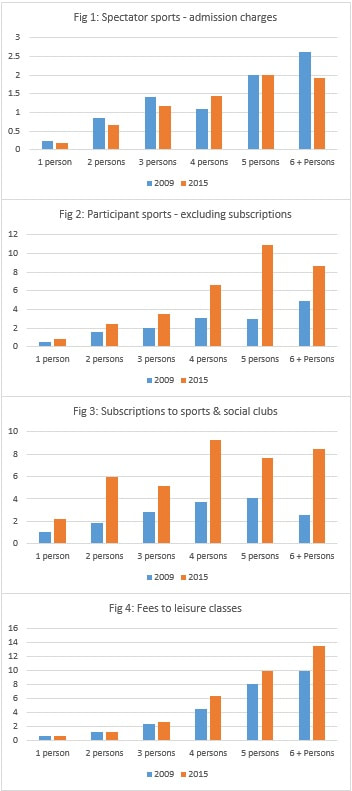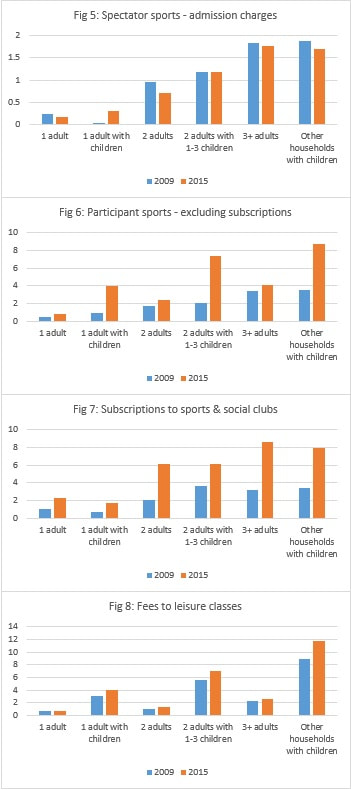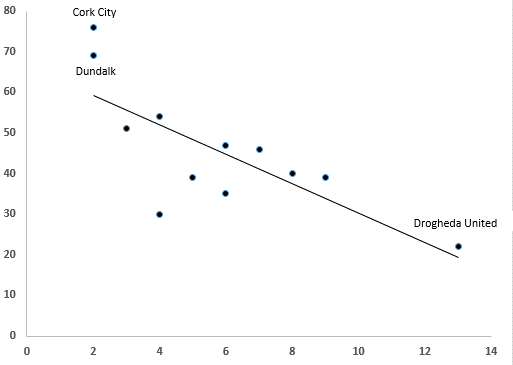We would like to wish all of our readers a happy Christmas and prosperous New Year.
|
We will be taking our usual Christmas break and will return on Monday the 15th of January.
We would like to wish all of our readers a happy Christmas and prosperous New Year. By Robbie Butler
The Department of Economics at Cork University Business School (UCC) Ireland, are pleased to invite applications for a specialist postgraduate research masters in sports economics. Participants in this programme will be enrolled in the full-time MSc (Commerce) - Economics (Full-Time) for one year, with a start date of October 2018. Applications should be made via the Postgraduate Application Centre (PAC) using the course code CKM07. Further details on the programme can be found here. By Robbie Butler
The 2018 sportseconomics.org Workshop on sport and economics, the 4th annual event of its kind, will be held on Monday 23rd and Tuesday 24th of July 2018 at University College Cork. The event will be hosted in conjunction with the Centre for Economic Analysis of Risk (CEAR) at Georgia State University in the United States. The theme of the two-day event will be ‘Sports Betting’. A range of speakers will be attending from institutes such as the University of Chicago, Georgia State University, University of Wisconsin-Madison, Clemson University, West Virginia University, London School of Economics, King’s College London and Lancaster University. More details regarding registration and proceedings will follow in Spring 2018. Local Organising Committee: David Butler, Robbie Butler, John Eakins and Don Ross. By Stephen Brosnan Previously, I have discussed (here & here) the determinants of player selection for the English football squad, specifically whether form or reputation is the dominant effect. Last week, Gareth Southgate stated that Joe Hart remains England’s number 1 for next summer’s World Cup. Southgate insisted that despite Hart’s club having a difficult start to the season, Hart has been excellent. This sentiment was clearly not shared by his new club manager, David Moyes, who dropped Hart for West Ham’s recent home fixture against Chelsea. To add insult to injury, Hart’s replacement kept a clean sheet (something which Hart has failed to do in his previous 7 games) in an unlikely win against Chelsea. This prompted me to analyse whether Hart remains England’s number 1 based on merit or reputation. Table 1 shows all English goalkeepers in the Premier League that have played 10 or more games this season ranked by Fantasy Premier League (FPL) points earned.  Table 1 Performance of England Goalkeepers in Fantasy Premier League 2017/18. *minimum 10 games played Table 1 Performance of England Goalkeepers in Fantasy Premier League 2017/18. *minimum 10 games played Fraser Forster leads the English goalkeepers across three categories – minutes played, saves and FPL points earned. Forster is also joint second for clean sheets and ranks second for FPL bonus points, awarded to players for outstanding performances in matches. One would expect given the high standard of his performances Forster would be an important member of the England squad. However, Southgate dropped the player for England’s recent international matches despite selecting four keepers – Joe Hart, Jack Butland, Jordan Pickford and Tom Heaton.
Similarly, Heaton’s replacement at Burnley since his injury – Nick Pope – has not been mentioned as a likely call up. Pope has the most clean sheets of all English keepers in the Premier League despite playing the least amount of minutes. Pope leads the English goalkeepers in FPL bonus points earned and ranks second overall in FPL points. One might suggest that Pope has benefitted from playing in a predominantly defensive set up at high-flying Burnley. However, Pope ranks third in total saves which suggests he has been far from a spectator in Burnley’s matches. England’s current keepers (Hart, Pickford and Butland) have failed to outperform Forster and Pope in any key performance category. Joe Hart has conceded the most goals and has made the least number of saves of all keepers included. Hart ranks third from bottom in FPL points won, FPL bonus points earned and clean sheets. Last week, Southgate claimed “I don’t think anyone else has had an opportunity yet to stake a strong enough claim to take over”. However, from an economist’s perspective, it is difficult to make a case statistically for Hart to remain as England’s first choice. By Sean O'Connor
Myself and Declan Jordan are currently working on a paper which poses the question, does diversity benefit team performance? Our period of analysis is the 2015/2016 season and we examine clubs from top flight leagues in England, France, Spain, the Netherlands, Germany, Italy, Spain and Portugal. We measure diversity based off of a player’s nationality. England is found to be the most diverse league in terms of different nationalities, whereas the Netherlands is the least diverse. For the period examined the most diverse teams in our data set are Watford, Roma, Udinese, Inter Milan and Swansea City. The least diverse are Athletic Bilbao, Sassulo, Excelsior, Real Sociedad and Heracles Almelo. In terms of diversity, Italy and England have the most heterogonous teams with both Watford and Swansea having two of the most diverse teams, with the other three in Italy. It might not be surprising that Athletic Bilbao is one of the least diverse teams, given their history of signing Basque players. Our preliminary results point to a number of aspects which can explain team performance. Not surprisingly we find that wealthier clubs perform better. However, we find that more diverse teams, on average actually perform worse, along with the interesting note that clubs who sign players from many different teams also on average perform worse. Clubs located closer to the capital city, along with those who employ a more experienced manager perform better in terms of points per game. Although the research is only at an early stage, we find the idea of sourcing players from a variety of different teams as being a negative to be an interesting finding. It may be that teams who have signed players who’ve previously played in the same club may already have a bond built up or a common understanding of how to play with each other, which in turn benefits their current team. We hope to explore these findings more in the coming months. By John Eakins Continuing my series of blog posts on Irish Household Sports Expenditures (previous posts here, here, and here), the following looks at household composition and household size. One would expect that the more persons in a household the larger the level of expenditure on sports related items but what might be of particular interest is the effect the composition of the household has on sports related expenditures, for example, households with children versus households without children. We first examine the effect of household size using the figures below (Figs 1-4). The trends observed in examining the data in previous blogs can be seen here once again, that is, decreases in spending on spectator sports between 2009-10 and increases in the other categories of sports spending over the same period, most notably for sports participation and subscription to sports and social clubs. A number of additional features of the graphs below are worth pointing out. For both sports participation and subscription to sports and social clubs, the larger increases are for households with 4 or more persons present. For example, spending on sports participation for households with 5 persons has increased 3 fold while subscriptions to sports and social clubs for households with 4 persons has more than doubled and for households with 6 or more persons has also increased 3 fold. In short, it’s appears that large households are driving the increase in sports spending. (It should be also be noted that the proportion of households with 4 or more persons in both HBS samples is roughly the same so this is a real increase in spending). It is probable that the patterns identified above are driven to a large extent by income. I have mentioned in previous blogs that spending on sports participation and subscriptions to sports clubs has increased primarily because of increases in spending by middle and high earners. Thus the more people in a household, the more the overall level of increase in household income. I also suggested that income may not be the only factor however. The figures below (Figs 5-8) examine the effect that household composition has on sports spending. Again, the overall pattern of decreases in spending on spectator sports and increases in the other categories of sports spending is evident across the categories of household composition. If we focus on spending on sports participation and subscription to sports and social clubs, we see an interesting pattern emerging. In the case of spending on sports participation, the larger increases are for those households with children present. In contrast for subscription to sports and social clubs the larger increases are (generally) for those households without children present. Thus it could be suggested that while spending on both categories is been driven by larger households, one (participant sports) is more due to the presence of children while the other (subscription to sports and social clubs) is more due to income increases. Fees to leisure classes are also more affected by the presence of children in the households than income (although not to the same extent as participant sports).
Whether children are present in the household or not and its effect on sports expenditures is an interesting topic. The conventional view is that children can preclude a household from engaging in sport due to time constraints. What the analysis presented in this blog suggests is that it depends on the type of sports/leisure activity the household engages in. Having children in the home may be a barrier to joining a sports club but it does not necessarily mean that the household cannot engage in a form of sports participation or leisure activity. Whilst we cannot say who is doing the sports/leisure activity (it could be just the children) this is a welcome trend for the overall health of Irish households. By Robbie Butler With the Festive season approaching the volume of live football shown on our screens tends to ramp up even further (if that is possible!). The hectic fixture list in the Premier League means clubs play seven games in just under four weeks.That's nearly 20% of the entire season squeezed into roughly 25 days. This schedule also coincides with the re-opening of the January transfer window and all of the drama attached. While most football fans are aware of this, spare a thought for the those currently out of work in the League of Ireland. The Professional Footballers Association of Ireland (PFAI) "is the sole representative organisation for all professional and semi-professional players playing in the FAI League of Ireland". In it's own words the association's mission is about "ensuring that its members are afforded the opportunity to develop their full potential in a professional and supportive environment...[and] aims to assist its members who are disengaged in seeking employment". Sadly, unemployment is a predicament almost all players playing in the League of Ireland face on an annual basis. This is compounded by the fact contracts for the vast majority expire in the weeks before Christmas. The PFAI lists its members seeking employment on its website (full transfer list here). Of the 106 players listed, 75 were last connected to a Premier Division club, while the remaining 31 were signed to a First Division team. The breakdown by position is as one might expect. Teams tend to field between 3 and 5 defenders and midfielders each, depending on tactics. These are the most represented on the list with 32 Defenders and 43 Midfielders searching for employment. Forwards make up 19 player on the list, while 13 Goalkeepers are currently seeking work. I have previously argued that the League should reconsider the open-system (promotion and relegation) currently in place. Failure is punished which does little to bring stability to the League as a whole. An examination of player releases this season in the Premier League supports this view. The scatter plot below illustrates the relationship between league points (y-axis) and players released (x-axis). The relationship is pretty clear, as the trend line demonstrates. The 1st and 2nd placed teams, Cork City and Dundalk, released just two PFAI members. The bottom club Drogheda United released the largest number, with 13 players now out of contract. The correlation between the two is -0.75.
This comes as no surprise to me. Relegation often brings with it large scale adjustment and downsizing. This can occur in both the size of the playing squad and the total wage bill. Usually it is both. Drogheda's failure during the 2017 campaign will no doubt have serious implications for the 2018 season. Unless the players released are recontracted, the club could start the new season with effectively a different squad of players. Such instability is not good for the club or the league, and can damage the relationship with fans as they find it difficult to identify with a team that is in a constant state of flux. By David Butler
For the last four seasons I’ve followed the pundits in their efforts to predict Premier League match outcomes. The stats for the last seasons can be viewed here. I pay particular attention to Mark Lawrenson (BBC) and Paul Merson (Sky) but there are other pundits that predict too. Our paper on this topic discusses the interesting behavioural quirks that arise when pundits make predictions. As we suspected, the patterns observed are consistent with a boundedly rational view of behaviour, insofar as it concerns making an estimate about the likelihood of a future event.The pundits seem to employ heuristics when it comes to guessing match outcomes. They favour specific score lines, particularly those ones that are easy to remember or imagine and systematically underestimate certain score lines. The chart below shows the performance of the pundits for this season. After 150 fixtures, the relatively stable ‘50/50 pattern’ emerges. The pundits call approximately half of the matches right. Predicting the score line prior to any given match is a notoriously tricky task. The pundits, just like you or me, will do well to predict more than one correct score line in any given game week. This comes out in the data time and time again. The worrying thing from a welfare perspective is that gambling firms specifically advertise score line ‘products’, taking advantage of gamblers poor probabilistic reasoning. As the data shows, just picking the outcome of a match is a difficult enough task, attempting to predict the score line too is extremely challenging and probably best avoided. By Robbie Butler
While most national football leagues are progressing toward their halfway point, the League of Ireland is currently in close season. This is because the league is structured around a February to October schedule, more commonly referred to as 'summer soccer. Yesterday the 2018 SSE Airtricity League format was confirmed. As is often the case, rule changes have been implemented. Much of the changes have taken placed in the 2nd tier of Irish football (First Division). This league will consist of 10 teams in 2018 (there had been between 8 and 10 for the past number of years) and involves an extended playoff scenario at the end of the season. To quote the source above directly it says: "The champions of the First Division will be guaranteed automatic promotion to the Premier Division where they will replace the team which finishes 10th in the top tier". This is standard practice. The big change revolves around the 4th placed team where: "the 2nd/3rd/4th placed clubs will go into the promotion/relegation play-offs at the end of the season. The team which finishes fourth will play the team which finishes third and the winner of that tie will face the team which finishes second. The winner of that tie will then play the team which finishes ninth in the Premier Division in the final promotion/relegation play-off, with all play-offs played over two legs". The reason the 4th place team is now 'lucky' is because 2nd and 3rd placed teams in seasons past (not the 2017 season) had entered a similar playoff. Why might this have happened? Economic theory can help. The First Division is effectively a closed system at one end (the bottom). In recent years, clubs have not been relegated to regional leagues (some have left voluntarily). This brings with it a certain set of incentives. With 10 teams in a league it is important to keep all interested as long as possible. Relegation does this for teams fighting at the bottom. Remove the threat of relegation and teams could simply lose interest mid-season if only the top two teams were promoted. Offering the 4th placed team a shot at promotion should keep lots of clubs interested throughout the season. For example, a club in 6th, 7th or even 8th with five games to go might still be only a handful of points off 4th spot and a possible play-off. Hopefully, this move will increase interest and activity in the all too often forgotten league in this country. |
Archives
March 2024
About
This website was founded in July 2013. Categories
All
|




 RSS Feed
RSS Feed